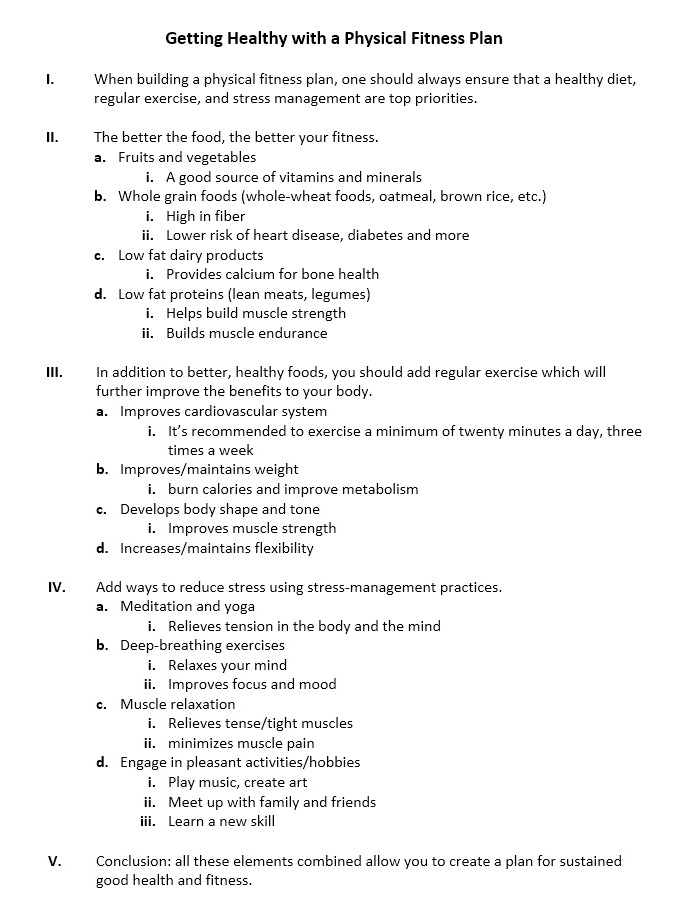9 Creating an Outline
To write well, you need to present your ideas in a highly organized way. An outline is the blueprint to your finished product.
Learning Objectives
After completing the activities in this chapter, you will be able to
- identify the steps needed to create an outline (Minnesota Libraries Publishing, 2015)
- create a thesis statement and outline (Minnesota Libraries Publishing, 2015)
Outlines
Writing an Outline[1]
For an essay question on a test or a brief oral presentation in class, all you may need to prepare is a short, informal outline in which you jot down key ideas in the order you will present them. This kind of outline reminds you to stay focused in a stressful situation and to include all the good ideas that help you explain or prove your point.
For a longer assignment, like an essay or a research paper, many college instructors require students to submit their outline for approval before writing and submitting the paper for grading. This is a way to be sure you are on the right track and are working in an organized manner.
A formal outline is a detailed guide that shows how all your supporting ideas relate to each other. It helps you distinguish between ideas that are of equal importance and ones that are of lesser importance. You build your paper based on the framework created by the outline.
Tip
Instructors may also require you to submit an outline with your final draft to check the direction of the assignment and the logic of your final draft. If you must submit an outline with the final draft of a paper, remember to revise the outline to reflect any changes you made while writing the paper.
Here’s an example of a detailed outline for a standard 5-paragraph essay[2]:

Notice that each body paragraph contains two to four main ideas (A-D) and that each main idea is further supported with specific details (1-4). In a research essay, those specific details should be facts from reliable sources and there should be an APA in-text citation (Author, year) next to each one.
Organizing Ideas[3]
The three common methods of organizing writing are chronological, spatial, and importance.
| Chronological order |
|
| Spatial Order |
|
| Order of Importance |
|
As you create your outline, be mindful of how you organize your supporting body paragraphs. In the example outline above, the writer has chosen to present ideas in “order of importance” with the final, and most persuasive, reason last. Putting the most important reason at the end is an effective strategy for persuasive writing.
Checklist: Writing an Effective Outline
- Do I have a controlling idea that guides the development of the entire piece of writing?
- Do I have three or more main points that I want to make in this piece of writing? Does each main point connect to my controlling idea?
- Is my outline in the best order—chronological order, spatial order, or order of importance—for me to present my main points? Will this order help me get my main point across?
- Do I have supporting details that will help me inform, explain, or prove my main points?
- Do I need to add more support? If so, where?
- Do I need to make any adjustments in my working thesis statement before I consider it the final version?
- Anonymous. (2015, October 27). 8.2 Outlining. In Writing for success. University of Minnesota Libraries. https://bit.ly/3jvW61b. CC BY-NC-SA 4.0. ↵
- Veillieux, H. (2021, April 9). 5POutlineExample [Digital Image]. In Writing the thesis and outline. Confederation College. https://bit.ly/36aiBWn. CC BY 4.0. ↵
- Anonymous. (2015, October 27). 8.2 Outlining. In Writing for success. University of Minnesota Libraries. https://open.lib.umn.edu/writingforsuccess/chapter/8-2-outlining/. CC BY-NC-SA 4.0. ↵
